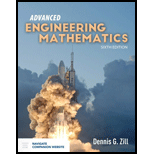
The value of
Explanation of Solution
Given:
The linear differential equation is
Concept used:
Runga-Kutta method:
The solution of a linear differential equation of the form
Euler’s method
The approximated solution for the first order linear differential equation of the form
Improved Euler’s method:
As per the Improved Euler’s method the solution of a linear differential equation of the form
Calculation:
The linear differential equation is given as follows:
The value of step size is given as
The initial value is given as
The given differential equation is of the form
This implies that
Obtain the solution of the given differential equation by Euler’s method for
As per the Euler’s method the solution of a linear differential equation of the form
Substitute
Substitute the value of
Therefore, the value of
Similarly, use the above procedure and the value of
|
|
| |
Table
Table
Obtain the solution of the given differential equation by Improved Euler’s method for
As per the Improved Euler’s method the solution of a linear differential equation of the form
Substitute
Substitute the value of
Substitute
Substitute the value of
Therefore, the value of
Similarly, with above procedure used the value of
|
|
| |
Table
Table
Obtain the solution of the given differential equation by Euler’s modified method for
As per the Runga-Kutta method of fourth order the value of
Here, the value of
Substitute
Calculate the value of
Calculate the value of
Further solve the above equation.
Calculate the value of
Calculate the value of
Substitute the value of
Therefore, the value of
Similarly, with above procedure used the value of
|
|
| |
Table
Table
The table which shows a comparison between the values of
|
|
|
|
|
|
| |
Table
Thus, table
Want to see more full solutions like this?
Chapter 6 Solutions
Advanced Engineering Mathematics
- In Problems 17–36, use Theorem 2 to find the local extrema.arrow_forwardIn Problems 1 through 6, express the solution of the given ini- tial value problem as a sum of two oscillations as in Eq. (8). Throughout, primes denote derivatives with respect to time t. In Problems 1–4, graph the solution function x(t) in such a way that you can identify and label (as in Fig. 3.6.2) its pe- riod. 1. x" + 9x = 10 cos 2t; x(0) = x'(0) = 0arrow_forwardIn Problems 1 through 6, express the solution of the given ini- tial value problem as a sum of two oscillations as in Eq. (8). Throughout, primes denote derivatives with respect to time t. In Problems 1–4, graph the solution function x(t) in such a way that you can identify and label (as in Fig. 3.6.2) its pe- riod. 2. x" + 4x = 5 sin 31; x(0) = x'(0) = 0arrow_forward
- 4. Show that 2 s w (b) L(t sinh (wt)) %3D (s² – w²)2 - ninearrow_forwardIn Problems 1 through 6, express the solution of the given ini- tial value problem as a sum of two oscillations as in Eq. (8). Throughout, primes denote derivatives with respect to time t. In Problems 1–4, graph the solution function x(t) in such a way that you can identify and label (as in Fig. 3.6.2) its pe- riod. 5. mx" +kx = Fo cos wt with w # wo; x(0) = xo, x'(0) = 0arrow_forward7. Evaluate Soy4 2 - y dy using Gamma/Beta function.arrow_forward
 Advanced Engineering MathematicsAdvanced MathISBN:9780470458365Author:Erwin KreyszigPublisher:Wiley, John & Sons, Incorporated
Advanced Engineering MathematicsAdvanced MathISBN:9780470458365Author:Erwin KreyszigPublisher:Wiley, John & Sons, Incorporated Numerical Methods for EngineersAdvanced MathISBN:9780073397924Author:Steven C. Chapra Dr., Raymond P. CanalePublisher:McGraw-Hill Education
Numerical Methods for EngineersAdvanced MathISBN:9780073397924Author:Steven C. Chapra Dr., Raymond P. CanalePublisher:McGraw-Hill Education Introductory Mathematics for Engineering Applicat...Advanced MathISBN:9781118141809Author:Nathan KlingbeilPublisher:WILEY
Introductory Mathematics for Engineering Applicat...Advanced MathISBN:9781118141809Author:Nathan KlingbeilPublisher:WILEY Mathematics For Machine TechnologyAdvanced MathISBN:9781337798310Author:Peterson, John.Publisher:Cengage Learning,
Mathematics For Machine TechnologyAdvanced MathISBN:9781337798310Author:Peterson, John.Publisher:Cengage Learning,






